Netflix’s series Tiger King sparked a lot of conversation about tiger conservation and animal welfare, with cub petting being at center stage. Unfortunately, the documentary did not include any unbiased experts (e.g. scientists, conservationists) to weigh in on this topic.
In the series, Joe Exotic, Doc Antle, Jeff Lowe, and Tim Stark, all owners of cub petting operations, say cub petting helps the conservation of big cats. But they also directly profit from cub petting. Joe Exotic said it is the main way that he makes money and would make tens of thousands of dollars a week when touring malls.
Carole Baskin, owner of Big Cat Rescue, a sanctuary that does not breed big cats, actively lobbies to Congress to stop the private breeding of big cats and explains to the viewer how cub petting is abusive to big cats. It’s difficult for the audience to believe her though as the zoo owners call her a hypocrite. They claim she is equally exploiting animals only without cub petting in a fake sanctuary. (You can read my thoughts on Big Cat Rescue here).
So who is telling the truth?
As an unbiased wildlife biologist with almost two decades of experience, I’m writing this post to give you the expert commentary that I wished the Netflix documentary included on cub petting. I worked at two AZA-accredited institutions for seven years in my past. I do not have any relationships between any of the facilities featured in the documentary and have nothing to gain. I am only interested in improving the lives of animals in captivity and conserving them in the wild.
Let’s get started.
In reference to tiger conservation on the series, Tim Stark, owner of Wildlife in Need says:
“Number one they are an endangered species, duh. What’s the first thing you should do to protect an endangered species – make more, not eliminate the source.”
Tim Stark, exotic animal breeder
I actually study and conduct research on the conservation of wild animals. In the last six years, I managed a citizen science camera trap projects in India and am very familiar with the threats tigers in their native range. Cub petting does next to nothing for the conservation of these big cats in the wild.
Breeding Does Not Automatically Equal Conservation
Just because an endangered species is bred in captivity, does not mean it is actually useful to species in the wild.
Yes, captive animals serve as a genetic reservoir should the endangered species face a major threat in the wild like a disease outbreak or a natural disaster, but AZA-accredited zoos already do this. They maintain studbooks of the animals and create Species Survival Programs that maximize the genetic diversity of the captive populations.
None of the zoos featured in Tiger King are AZA-accredited zoos (check out my reviews of Joe Exotic’s Zoo and Myrtle Beach Safari). They do not maintain studbooks of genetic information about the animals and hybridize subspecies. These zoos therefore cannot and do not contribute to the Species Survival Programs of big cats in captivity.
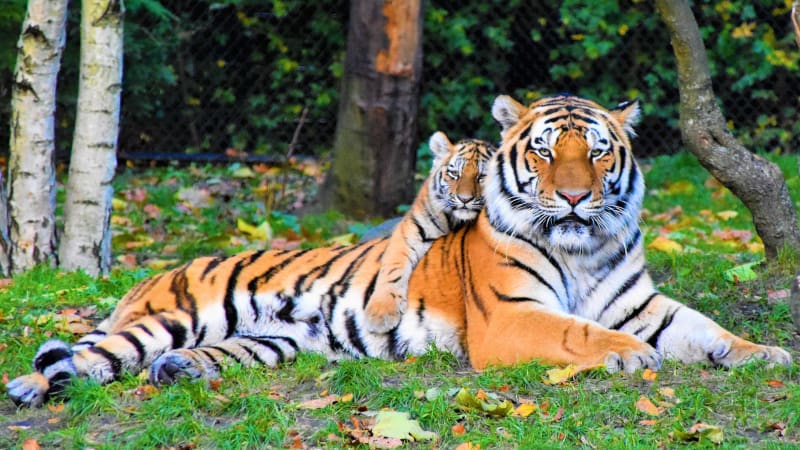
Many species, like big cats, breed perfectly well in captivity. There enough individuals to breed, but zoos need to make sure the right individuals breed.
The Copenhagen Zoo famously euthanized and dissected a perfectly healthy giraffe a few years ago and received a lot of public outrage. Giraffes are a threatened species in the wild (and may even be endangered if divided into multiple species).
Because this giraffe was too genetically similar to the other captive individuals, he would not increase the genetic diversity of the captive population. The zoo didn’t have enough space for him and a new, more genetically diverse individual, so the giraffe was put down.
Cats Used for Cub Petting Can Never Be Released to the Wild
Many people argue that the cubs Joe Exotic, Doc Antle, and Jeff Lowe bred, and even the cats at Big Cat Rescue should be set free to the wild.
As nice as this sounds, hand-raised captive bred animals cannot be released. They will not survive.
In Tiger King, you saw footage of an employee of the Greater Wynnewood Exotic Animal Park taking tiger cubs immediately from their mom the exact moment she gave birth. Joe took these cubs and put them in a crib in his living room.
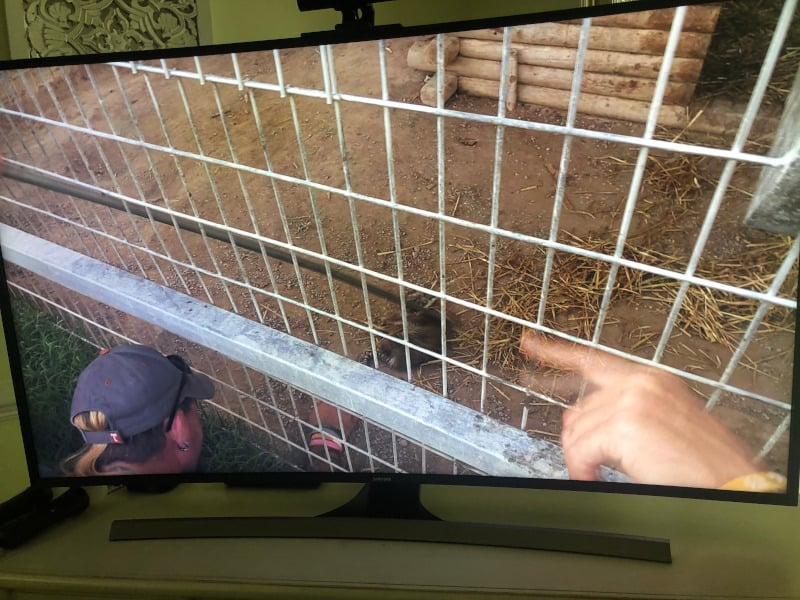
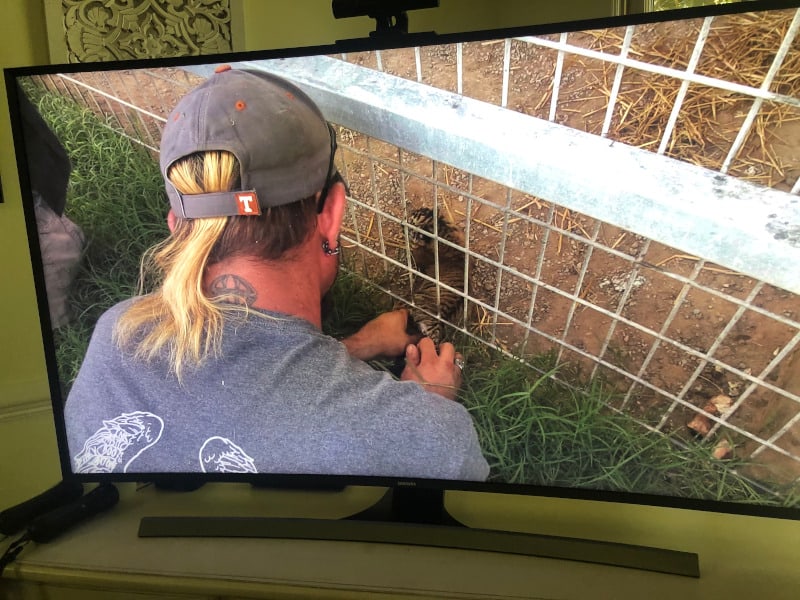
To tame big cats for cub petting and close contact with the public, you have to separate them from the mom. Big cats are not domesticated like our pet cats. Domestic cats co-evolved with humans thousands of years ago and have genetic differences that make them more able to live with humans. For example, research shows they understand our pointing.
Breeders break the mother-cub bond so the cubs will form a bond with the breeder instead. Tiger cubs are born helpless with their eyes closed and rely on their mother entirely. They stay with their mothers for up to three years. During these years, big cat moms teach their cubs survival skills, like how to hunt. According to big cat scientist Dr. Tara Pirie,
“It can take cubs a year or more of training from their mother to develop and hone the skills of locating, stalking, capturing and dispatching their prey, before they are able to survive on their own.“
Dr. Tara Pirie, big cat scientist
A hand-reared cub is unlikely to survive in the wild because it won’t have any of these skills. Given how tame they are, they would also be dangerous to the local community. Here in the US, we have to euthanize or relocate bears people intentionally feed giving meaning to the phrase “a fed bear is a dead bear.”
Scientists breed endangered species for reintroduction programs in a very intentional way. Frequently, the initial animals for captive breeding are captured from the wild and are not captive species to begin with. When populations are critically low for species, like less than a hundred individuals, scientists will capture them specifically for captive breeding and species reintroduction programs. This is used as a last resort option.
Scientists and veterinarians breed the animals a way to increase the likelihood of their survival when reintroduced into the wild. There is minimal or no direct contact with humans.
Nowhere to Go
A key component of a reintroduction program is to have habitat for the animal to live in once released into the wild. Sure, there are more captive tigers in the US than there are in the wild, but even if they could survive in the wild (which they can’t), where would they go?
The biggest threat to tigers and other big cats around the world is habitat loss. Tigers need a lot of space and if there are no large areas of suitable habitat that can include more tigers, they will not survive.
India faces this challenge with tiger conservation right now. This country holds 70% of the world’s tiger population. In the past few decades, the government has prioritized tiger conservation through protected areas. The tiger population grew because of this protection. Tiger reproduction is not a problem in the wild.
The tiger reserves in India only provide so much space though and eventually the tiger population will hit a maximum capacity. Tigers are solitary (except for mom and cubs) and territorial. Tigers do not live in big groups, unlike what you saw in the cages of the Greater Wynnewood Exotic Animal Park. Territorial species will actively try to remove other individuals from the same species from their territories.
Young tigers need somewhere to live when they grow up. Just like human children leave the house when they become adults, tigers do the same thing. The young tigers are forced to disperse into the surrounding landscape, which is where people live.
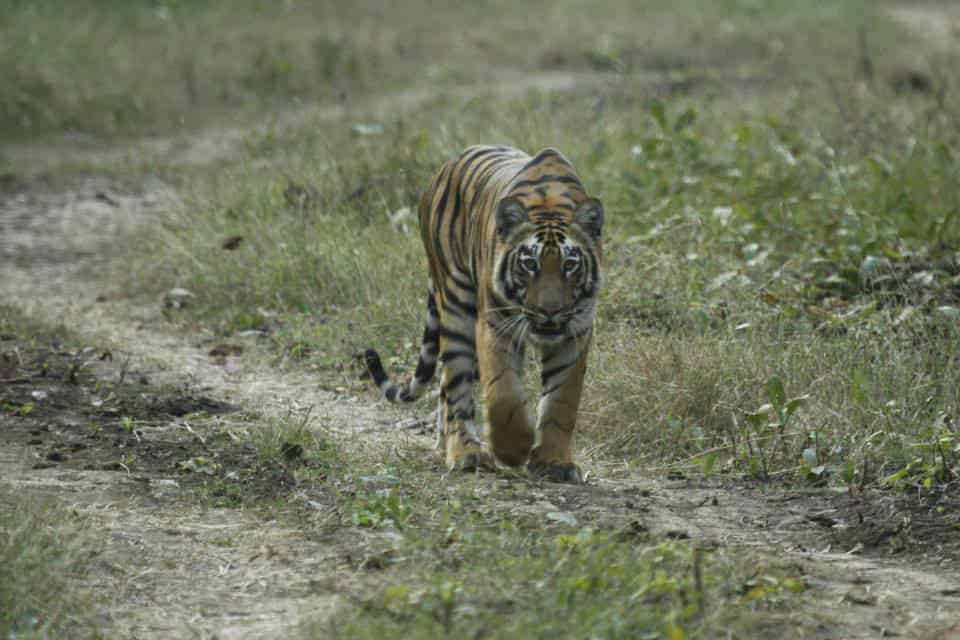
As you can imagine, this leads to conflict. India is the second most populated country in the world. I visited rural areas in India and still felt like they were pretty populated. In the eastern US, we’ve killed all of our apex predators, but Indians in tiger range have to live with tigers. Tigers sometimes kill people and livestock, which can lead people to retaliate and kill the tigers.
Additionally, it is essential to provide tigers with safe areas (corridors) that they can use to travel in between parks. If tigers only stay in their park, inbreeding will happen, which can cause major health problems for big cats. Inbred Florida panthers suffered from heart defects and reproduction problems. Eventually scientists brought in a different subspecies from Texas to mate with the Florida panthers and genetically “rescue” the population from these health problems.
As important as space, tigers need food. Just because you see a forest, does not mean there is enough prey in it to support tigers. In Africa and Asia, conservationists frequently talk about “empty forests.” These forests are intact and on paper as protected areas, but poachers kill most of the wildlife for food or trade.
Research shows there is a direct relationship between the abundance of tiger prey and tigers. In other words, tigers will not survive even in large areas of undeveloped land with no people if there is no food for them to hunt.
Poaching is a also a problem for tigers. People still poach tigers for their skins and body parts which are used in Chinese medicine. It would be counterintuitive to release captive-bred tigers into areas with heavy poaching.
Extremely Expensive
Even if you could release hand-raised cubs back into the wild (which you can’t) and there was habitat, this would be incredibly expensive and extremely stressful for the animals. The cubs live in the United States and would to travel to Africa or Asia (most cub petting operations use tigers or lions).
Think about the cages needed for travel, the veterinarian team to administer them and monitor the animals, and the transportation to get the animals from the airport to the wild. From my experiences working in Kenya, I can tell you that this alone would require hours of driving on dirt roads. Wouldn’t it make more sense to use that money towards the conservation and protection of species already in the wild?
Sanctuaries or zoos that operate reintroduction programs are almost always located close or in the native range of the animal, or the animals are easy to transport. A lot of ethical zoos in the United States do reintroduction programs for smaller species like frogs, fish, and even insects. In my sanctuary post, I discussed Lola Ya Bonobo, a bonobo sanctuary that has successfully released orphaned bonobos into the wild of the Democratic Republic of Congo, the country the sanctuary is located in.
The Argument for Cub Petting as Conservation
Cub petting could help the conservation of wild cats if after petting a cub, people are inspired to take a conservation action. This is a BIG IF. And there are animal welfare concerns to weigh (more on this later).
In addition to wildlife research, I also conduct social science research on people’s attitudes towards wildlife. I conducted a study on the impacts of citizen science on volunteers’ attitudes and outcomes. It is very hard to change people’s attitudes and even harder to change their behaviors.
Think about the last time you visited a zoo or had a close up interaction with a captive wild animal. Did you donate at the zoo or event? Maybe you did that day, but do you still donate today? Have you changed anything about the way you go about life because of this experience?
Unfortunately for a majority of the people, this is probably a no.
“You get 15 minutes with a baby tiger and you say look we gotta save the rainforest. They leave with a whole different attitude.”
Joe Exotic, Big cat breeder and former Owner of the Greater Wynnewood Zoo
Let’s examine Joe Exotic’s quote above. First it is wrong because many tigers do not live in rainforests (you can see the dry forest I visited in India on my tiger safari). Regardless, the major ways that you can help tigers are:
- Make donations to reputable organizations like the Wildlife Conservation Society, the World Wildlife Fund, and Conservation International that fund tiger conservation research and anti-poaching patrols
- Only buy products with sustainable palm oil, and pressure companies to change to sustainable palm oil. Also pressure companies that are in the Roundtable for Sustainable Palm Oil to increase their standards to be more in favor of conservation
- Reduce your impact on climate change (there are many things you can do)
- Write letters and make calls to your government officials and pressure them to fund international endangered species conservation funds
Do you honestly think Joe Exotic said even says one of those things to park visitors? I can’t say 100%, as this could be something Netflix cut out, but it is highly doubtful.
Maybe Joe Exotic donates to conservation organizations with the money he gets from cub petting. Again, this is highly unlikely given all of the financial strain he was under as documented in the series. I also could find no evidence of conservation donations on the Greater Wynnewood Exotic Animal Park website (now owned by Jeff Lowe).
Conservationists also point out that cub petting can initiate conservation problems. Tiger parts may be sold illegally for Chinese medicine increasing demand. This may increase tiger poaching in range countries.
Panthera believes that commercial breeding of #tigers for non-conservation purposes poses a threat to critically endangered wild populations and should not be permitted. @LiveScience explains why Netflix's #TigerKing has nothing to do with #conservation: https://t.co/pUOQ7PiEDG pic.twitter.com/kj3nYqNobw
— Panthera (@PantheraCats) April 16, 2020
Again, Doc Antle, owner of Big Cat Safari, argues that cub petting helps conservation through all of the money raised. He has his own conservation organization called the Rare Species Fund. In my 17 years of being in this field, I have never heard of this fund.
“We believe these (experiences) creates a connection between us and them (wild animals) so they’ll open their hearts and their wallets to do our worldwide conservation work.”
Doc Antle, Big cat breeder and owner of Myrtle Beach Safari
But I looked into it. I will go into the Rare Species Fund more in detail when I write about Myrtle Beach Safari, but to me, the Rare Species Fund looks like a cover for Doc Antle to justify cub petting.
There are no people other than Doc Antle listed for “Who We Are.” Doc Antle has a blog about the Rare Species Fund’s projects and it does look like they fund some international projects that could be helpful for conservation. However, Doc has not updated this blog in terms of conservation projects since June of 2019 and they only had two blog posts for 2019.
It is not clear how much the Rare Species Fund donates to conservation, but my guess would be tens of thousands of dollars (based on my own experience creating budgets for international research. They fund camera trap work, rangers’ salaries, and housing projects in developing countries.
This report stated they donated almost $16,000 to monitor the health of the local community living near gorillas and this report stated they donated over $100,000. The most recent posting of their donations is from 2017. It is very difficult to tell how much they donate and how often. It looks like Doc Antle charges at least $339 per person for cub petting.
After I finished writing this section, this news article was released on this very subject. “The Rare Species Fund has brought in more than $1.5 million between 2014 and 2018..but most of that money appears to have been spent caring for what it calls its “animal ambassadors,” which are based at the Myrtle Beach facility. More than $1 million has been spent on animal food and care or habitat repair and construction compared to about $500,000 on grants to organizations. That includes about $282,000 in grants to domestic organizations and $216,000 to foreign groups.”
Another scientist quoted in the article supports what I speculate; the Rare Species Fund is a front to justify cub petting.
Do these donations to conservation justify cub petting? My professional opinion next.
Cub Petting is a Form of Animal Abuse
No, these conservation donations do not justify conservation because cub petting is a form of animal abuse. In the wild, tigers have several cubs every 2-3 years. After the cubs disperse from the mom, she goes into estrus again, and can become pregnant.
Cub petting operations need a constant supply of cubs year round. Before they turn eight weeks old, they are too young to be handled and after 12 weeks they are too big and dangerous. This means that each cub is only good for one month of petting.
Female tigers are therefore bred constantly. As you saw in Tiger King, an employee of the Greater Wynnewood Exotic Animal Park removed the cubs from the mother immediately upon birth. Animals that lose their offspring can then go into estrus again. She will be bred soon after.
The cubs grow up without their mother. In Tiger King, you can hear the cubs cry when Joe Exotic puts them in the crib in his living room. He states the cubs cried so much throughout the night that he had to sleep in the studio. This is equally sad for the mother. Many mammals form strong bonds with their offspring and taking the cub away from the mom is cruel. Ethical zoos keep the cubs with their mom.
Carole Baskin stated you need to have about 50 tigers to breed to have a cub petting operation. Both Joe and Doc’s zoos had hundreds of tigers at a time (Joe said 227 with 20 more coming at one point).
No zoo, even the best zoo in the world, can hold an endless supply of cubs. As I mentioned above, tigers can even reach maximum capacity in the wild in protected areas. The big question is then where do all of the cubs go once they are too big?
The number one rule of business…you can’t keep them all. Once a tiger gets out of the stage where you can use them, they are a bill then.”
Tim Stark recalling what Doc Antler said to Joe Exotic
The cubs are then sold to private individuals, roadside zoos, or canned hunts (places where people hunt captive animals in fenced areas). As the Netflix documentary pointed out, selling endangered species is illegal.
Tourism drives tiger breeding in the U.S., where many roadside zoos and other businesses charge guests to pet and pose with cubs. https://t.co/NVq8igIMyv
— National Geographic (@NatGeo) December 4, 2019
According to this National Geographic article, “There’s evidence that some are killed.” We know that Joe Exotic shot at least five of his own tigers. At his trial he said, “In twenty years I’ve had fifty plus tigers buried in that back pasture, and nobody gives a damn. Nobody.” Joe and supporters argue that he was humanely euthanizing them because they were sick or old. But we don’t know this for sure, and if it were true, why would he not call a vet to do it?
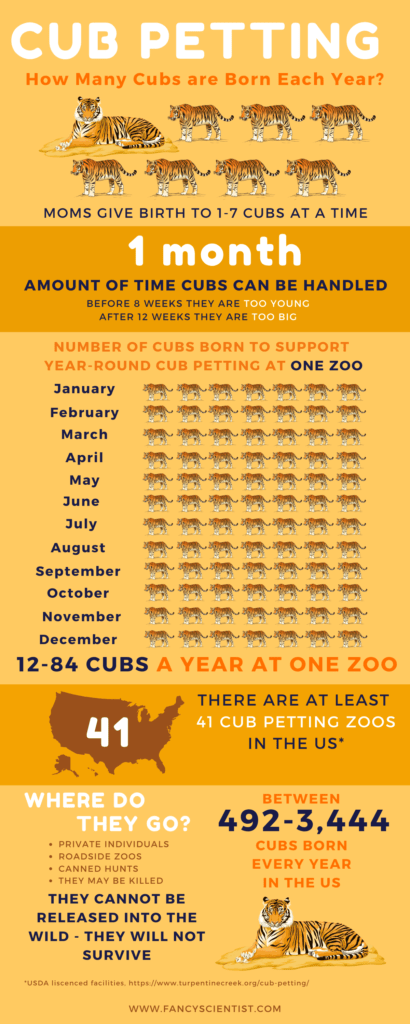
If you listen to the Wondery podcast on Joe Exotic, they discuss how the cubs were always sick. It’s a shame that the Netflix series did not include this even though the directors saw it.
Most of the tigers we were around were subjected to abject cruelty. We saw babies being torn from their mothers and screaming. They’d get sick from being handled so much and get ringworm and mange. It was disturbing. Are they cute? Yes. Were there temptations to cuddle or touch? Yes. But it was very clear that it was not something positive.
Rebecca Chaiklin, Co-director and writer of the Netflix Tiger King Series
Finally, interacting with the cubs is probably not fun for them. Lots of times people think animals are having fun just because they are cute and walking around, but remember they are not with their mother and constantly being held, which is not normal.
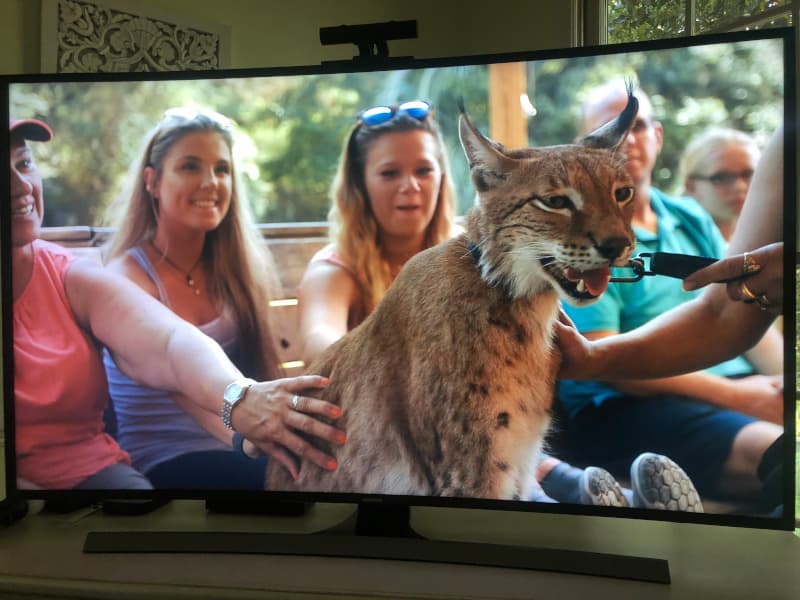
Essentially one month after you are finished petting a cub, they are killed or live terrible lives. In my opinion, it is not worth it for an animal to suffer a lifetime of abuse or be killed to justify spending $500,000 over four years on big cat conservation in the wild. Rather than engage in cub petting, I suggest you invest the hundreds of dollars you would have spent on real conservation organizations that do real conservation work.
Check out my podcast episode on animals in captivity for more Tiger King talk.
Love this post? Share it with friends!



